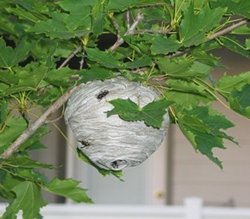Dublin Beekeeping Services
Honeybee & Swarm Removal Service

Wasp
Wasps
Identification
A typical wasp worker is about 12 mm (0.5 inches) long, with black bands on a yellow abdomen while the queen is larger, about 19 mm (0.75 inches) long (the different patterns on the abdomen and face help separate various species). Workers are sometimes confused with honey bees, especially when flying in and out of their nests.
Wasps, in contrast to honey bees, are not covered with tan-brown dense hair on their bodies and lack the flattened hairy hind legs used to carry pollen. Wasps have a lance-like stinger and typically sting repeatedly, the venom, like most bee/wasp venoms, is primarily only dangerous to those who are allergic, unless a victim receives a large number of stings.

Wasp nest
Mouthparts are well-developed for capturing and chewing insects, with a proboscis (tongue) for sucking nectar, fruit and other juices.
Nests are built in trees, shrubs or in protected places such as inside human-made structures (attics, hollow walls or flooring, in sheds, under porches and eaves of houses), or in soil cavities, mouse burrows, etc. Nests are made from wood fibre chewed into a paper-like pulp.
Life cycle and habits
Wasps are social hunters living in colonies containing, workers, queens and males. Colonies are annual with only inseminated queens overwintering. This season's newly fertilized queens will hibernate for the winter in protected places such as hollow trees, under logs, in soil cavities and human-made structures. Queens emerge during the warm days of late spring or early summer, select a nest site and build a small paper nest in which eggs are laid. After eggs hatch from the 10 to 12 brood cells, the queen feeds the young larvae for about 18 to 20 days, emerging as small, infertile females called workers, and assume the tasks of nest expansion, foraging for food, care of the queen and larvae, and colony defence. All females are capable of stinging.

Wasp nest in a bush
From this time until her death in the autumn, the queen remains inside the nest laying eggs. The colony then expands rapidly reaching a maximum size of several thousand workers in late summer. At peak size, new males and queens are produced. New queens mate and build up fat reserves, and then seek protected places to overwinter. Parent colony workers dwindle, usually leaving the nest and die, as well the old queen. Abandoned nests disintegrate overtime, but are not used again. In the spring, the cycle is repeated.
Although adults feed primarily on items rich in sugars (fruits, flower nectar and tree sap), the larvae are fed proteins such as insects, meats, etc. Adult workers chew and condition the meat, before feeding to the larvae. Larvae in return secrete a sugar liquid relished by the adults, an exchange of material known as trophollaxic. In late summer, larvae in the nest fail to meet the requirements of a source of sugar for foraging workers (nuisance scavengers) and they then change their food preference from meat to a high sugar diet like ripe decaying fruits, scavenge rubbish bins, sweets drinks, picnics, etc. Wasps are important predators of pest insects.